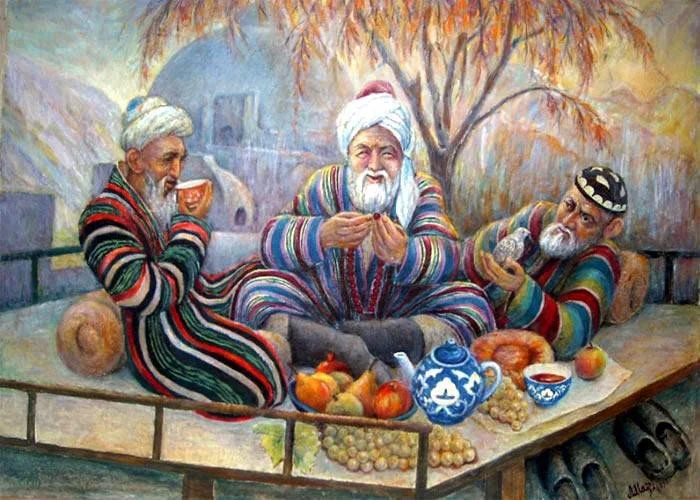Liquid Meditation
Tea has the power to positively influence family relationships.
In my family, this stems from a centuries old tradition in Central Asia, where people would frequently gather in teahouses called chaikhana.
In addition to tea, a lavish meal consisting of plof, kebabs, samsa, salads, dumplings, lagman soup and traditional bread would be laid out. Sweets like navot (rock candy infused with saffron) and fresh local fruits were also served.
People sat on elevated mattress beds called a tapchan. In the warmer months, this was outdoors, usually facing a scenic view. Just imagine looking out to a garden or small body of water, enjoying the cool breeze under the trees, and the gentle yet cheerful sound of birds chirping in the background. Dressed in comfortable silk robes (han-atlas), and presented with an equally colorful food spread to accompany the tea drinking, the senses are aroused. A calm and relaxing atmosphere is created.
Pleasant conversation develops with each soothing sip. Ideas are exchanged. Sometimes, local poets and musicians would share sweet words and melodies with the guests that lifted their souls. The essence of the experience was to separate from the mundane and tune into the natural world and ourselves. Noone felt rushed. Mind and body were one.
Fast forward to the nineties.
As a child, I would come home from school, and make myself comfortable on the couch to watch some of my favorite afternoon shows. I also waited for my mother to arrive from work. Around 4PM, I would see her walk up the pathway to our front door. In anticipation of her arrival, I had a pot of water on the stovetop ready to boil. I would open the door and often notice a tired look on her face. I would ask, “green or black?” even though I knew the answer.
I turned off the television, and poured a splash of boiling water into our traditional pahta gul teapot, washing out any remaining tea leaves.
Traditional pahta gul china set; Large serving plate, teapot, and salt and pepper shakers. Pachta gul is a Tadjik term, meaning cotton flower. This blue and white design is painted on dishes and tea sets, and is commonly found in homes of Central Asian origin. Cotton was the agricultural commodity of the region during Soviet Rule. It was celebrated for its utility as well as its beauty.
I added a teaspoon and a half of loose green tea and poured the rest of the boiling water to fill the pot.
Covered in a tea cozy, I brought the pot along with a few pyola (teacups) and took a seat at the table with my mother. One pyola is to brew and aerate the tea, the others are for serving and the last is to spill cooled leftovers into, so that each person is always enjoying their drink hot.
I let the brewed tea leaves swirl down to the bottom of the teapot and then begin serving. I poured for myself first, let it sit for a minute or two, and then took my first sip. This is the custom, to show my guest that the tea is edible.
I would then pass a cup of tea to my mother from my right hand to hers. Now we’re relaxed. The small talk is over and the real conversation begins.
We would share how our day went, the different scenarios we faced and how we navigate through them. We talked about how it made us feel, if we should have said something different, or approached the situation from a better angle. We gave each other updates on what was going on in our lives and what was to come. From piano recitals to family events, we had much to look forward to.
We would share unique insights from books and articles we’ve read, or the interesting conversations we’ve had throughout the day. At one point, all I could talk about was my excitement for the Harry Potter series.
I learned more about my family, my ancestral history, and the story of our immigration to the United States.
I vicariously learned about personality types and human dynamics from my mother’s challenges with unpleasant people. I developed empathy and emotional intelligence.
We would laugh, or cry, or sometimes sit in a shared silence. Most importantly, we offered a listening ear, a helping hand, a hug or a smile.
Once the teapot was finished, we usually made a second one. And by the middle of the second pot we felt we’ve talked things out enough to move on with the rest of our day. The experience was enlightening and therapeutic. We would emerge relaxed, recharged and reconnected.
Every family should incorporate a stopping point of connection into their daily routine.
Children learn to check-in with themselves and feel comfortable enough to share what’s on their mind. They learn to speak up and learn to listen to what others have to say.
I like to call it liquid meditation. But we never called it that as a family. We just had tea, everyday, from the first beverage we consumed in the morning to the last beverage we consumed at night. Yes, it was our main form of hydration, but more importantly, we used it to build deeper connections with ourselves, our family and community. It may not be as lavish as in the chaikhana, but the essence is always the same- pause, invite warmth, and connect.
Do you carry a daily ritual from childhood that fosters positive family relationships? Would you create one moving forward?




